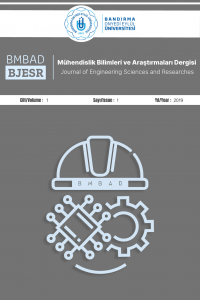AĞIRLIKLI ARTIK YÖNTEMLERİN SINIR TABAKA PROBLEMLERİNE UYGULANMASI
Sınır Tabaka Problemleri, Falkner ve Skan Denklemi, Ağırlıklı Artık Yöntemler, En Küçük Kareler Yöntemi, Nonlineer Diferansiyel Denklemler
AN APPLICATION OF THE METHOD OF WEIGHTED RESIDUALS TO THE BOUNDARY LAYER PROBLEMS
Boundary Layer Problems, Falkner and Skan Equation, Method of Weighted Residuals, Least Squares Method, Nonlinear Differential Equations,
___
- L. Prandtl, “Ueber die Fl¨ussigkeitsbewegung bei sehr kliner Ribung” In Verhandlungen des III. Internationalen Mathematiker-Kongress, Heidelberg, pp. 484-491, 1904.
- J.A. Schetz and R.D.W. Bowersox, “Boundary Layer Analysis”. Sec. Edition, New Jersey, Prentice-Hall Inc., 2011.
- T. Cebeci and H.B. Keller “Shooting and Parallel Shooting Methods for Solving the Falkner-Skan Boundary-Layer Equation,” Journal of Computational Phsics, vol. 7 pp. 289-300, 1971.
- H. Blasius, “Grenzschichten in Flüssigkeiten mit kleiner Reibung.” Z. Angew. Math. Phys., vol. 56, pp. 1–37, 1908.
- K. Hiemenz, “Die Grenzschicht an einem in den gleichförmigen Flüssigkeitsstrom eingetauchten geraden Kreiszylinder,” Dingler’s Polytech. J., vol. 324, pp. 321-324, 1911.
- V.M. Falkner and S.W. Skan, “Some Approximate Solutions of the Boundary Layer Equations,” Philosophical Magazine, vol. 12, pp. 865-896, 1930.
- C. Laine and L. Reinhart, “Further numerical methods for the Falkner-Skan equaitons: shooting and continuation techniques,” I. J. Num. Meth. Fluids, vol. 4, pp. 833–852, 1984.
- R. Fazio, “A novel approach to the numerical solution of boundary value problems on infinite intervals,” SIAM J. Num. Anal., vol. 33, no. 4, pp. 1473–1483, 1996.
- A. Asaithambi, “A finite-difference method for the Falkner-Skan equation,” Appl. Math. Comp., vol. 92, pp. 135–141, 1998.
- S.S. Motsa and P. Sibanda, “An efficient numerical method for solving Falkner-Skan boundary layer flows,” I.J. Num. Meth. Fluids, vol. 69, pp. 499–508, 2012.
- R. Fazio, “Blasius problem and Falkner-Skan model: T¨opfer’s algorithm and its extension,” Comp. Fluids, vol. 73, no. 15, pp. 202–209, 2013.
- C.S. Liu, “An iterative method based-on eigenfunctions and adjoint eigenfunctions for solving the Falkner-Skan equation,” Appl. Math. Lett., vol. 67, pp. 33–39, 2017.
- H. Bararnia, N. Haghparast, M. Miansari, and A. Barari, “Flow analysis for the Falkner-Skan wedge flow,” Curr.Sci., vol. 103, no. 2, pp. 169–177, 2012.
- B.I. Yun, “New approximate analytical solutions of the Falkner-Skan equation,” Journal of Applied Mathematics, vol. 2012, pp.1–12, 2012.
- A. Khidir, “A note on the solution of general Falkner-Skan problem by two novel semi-analytical technique,” Propul. Power Res., vol. 4, no. 4, pp. 212–220, 2015.
- B.A. Finlayson, “The Method of Weighted Residuals and Variational Principles With Applications in Fluid Mechanics,” Academic Press, New York and London, 1972.
- S.C. Chapra and R.P. Canale “Numerical Methods for Engineers,” 6th Edition, McGraw-Hill, New York, 2010.
- M. Abramowitz and I.A. Stegun, “Handbook of Mathematical Functions with Formulas, Graphs, and Mathematical Tables,” 9th printing. New York: Dover, 1972.
- D.R. Hartree, “On an equation occuring in Falkner and Skan’s approximate treatment of the equations of the boundary layer,” Proc. Cambridge Phil. Sot., vol. 33, pp. 223-239. (1937).
- A. Asaithambi, “A second-order finite-difference method for the Falkner–Skan equation,” Applied Mathematics and Computation, vol. 156, pp. 779–786, 2004.
- ISSN: 2687-4415
- Yayın Aralığı: Yılda 2 Sayı
- Başlangıç: 2019
- Yayıncı: Bandırma Onyedi Eylül Üniversitesi
FOTOVOLTAİK PANELİN TEK DİYOTLU MODELLENMESİ
Fıstık Kabuğu Üzerinde Sulu Çözeltilerden Adsorpsiyon İle Kongo Kırmızının Uzaklaştırılması
AĞIRLIKLI ARTIK YÖNTEMLERİN SINIR TABAKA PROBLEMLERİNE UYGULANMASI
Farklı Tip LED Sürücülerin Güç Kalitesi Performanslarının Belirlenmesi
Erdem TÜRKMEN, Ramazan AYAZ, Kadir DOĞANŞAHİN, Bedri KEKEZOĞLU
İNDÜKSİYON ISITMADA ÇALIŞMA FREKANSININ ISITMA DERİNLİĞİNE ETKİSİ
Adem DALCALI, Harun ÖZBAY, Selim ÖNCÜ
